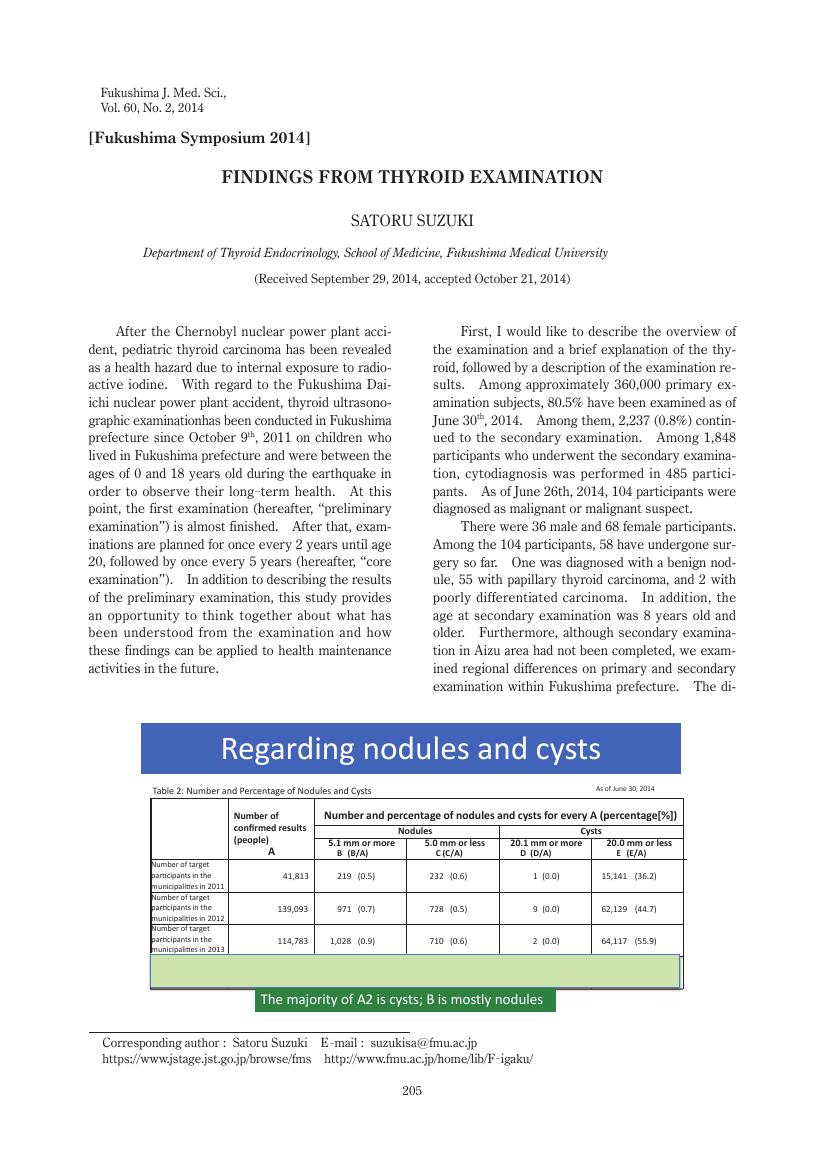1 0 0 0 OA RADIOACTIVE SUBSTANCES IN TAP WATER
- 著者
- RYO ATSUUMI YOSHIHIKO ENDO AKIHIKO SUZUKI YASUMITU KANNOTOU MASAHIRO NAKADA REIKO YABUUCHI
- 出版者
- 福島医学会
- 雑誌
- FUKUSHIMA JOURNAL OF MEDICAL SCIENCE (ISSN:00162590)
- 巻号頁・発行日
- vol.60, no.1, pp.101-105, 2014 (Released:2014-08-08)
- 参考文献数
- 6
- 被引用文献数
- 1 2
A 9.0 magnitude (M) earthquake with an epicenter off the Sanriku coast occurred at 14: 46 on March 11, 2011. TEPCO Fukushima Daiichi Nuclear Power Plant (F-1 NPP) was struck by the earthquake and its resulting tsunami. Consequently a critical nuclear disaster developed, as a large quantity of radioactive materials was released due to a hydrogen blast. On March 16th, 2011, radioiodine and radioactive cesium were detected at levels of 177 Bq/kg and 58 Bq/kg, respectively, in tap water in Fukushima city (about 62km northwest of TEPCO F-1 NPP). On March 20th, radioiodine was detected in tap water at a level of 965 Bq/kg, which is over the value-index of restrictions on food and drink intake (radioiodine 300 Bq/kg (infant intake 100 Bq/kg)) designated by the Nuclear Safety Commission. Therefore, intake restriction measures were taken regarding drinking water. After that, although the all intake restrictions were lifted, in order to confirm the safety of tap water, an inspection system was established to monitor all tap water in the prefecture. This system has confirmed that there has been no detection of radioiodine or radioactive cesium in tap water in the prefecture since May 5th, 2011. Furthermore, radioactive strontium (89 Sr, 90Sr) and plutonium (238Pu, 239Pu+240Pu) in tap water and the raw water supply were measured. As a result, 89 Sr, 238Pu, 239Pu+240Pu were undetectable and although 90Sr was detected, its committed effective dose of 0.00017 mSv was much lower than the yearly 0.1 mSv of the World Health Organization guidelines for drinking water quality. In addition, the results did not show any deviations from past inspection results.
1 0 0 0 OA FINDINGS FROM THYROID EXAMINATION
- 著者
- SATORU SUZUKI
- 出版者
- 福島医学会
- 雑誌
- FUKUSHIMA JOURNAL OF MEDICAL SCIENCE (ISSN:00162590)
- 巻号頁・発行日
- vol.60, no.2, pp.205-206, 2014 (Released:2015-02-26)
- 被引用文献数
- 1 1
- 著者
- HIROSHI OGATA MIDORI YATABE SHINGEN MISAKA YAYOI SHIKAMA SUGURU SATO MITSURU MUNAKATA JUNKO KIMURA
- 出版者
- 福島医学会
- 雑誌
- FUKUSHIMA JOURNAL OF MEDICAL SCIENCE (ISSN:00162590)
- 巻号頁・発行日
- vol.59, no.1, pp.43-48, 2013 (Released:2013-07-10)
- 参考文献数
- 25
- 被引用文献数
- 1
We previously reported a case of pulmonary hypertension, where the symptoms were improved by oral L-arginine (arginine) administration. Arginine may increase nitric oxide (NO) production in the pulmonary artery. Exhaled NO may reflect pulmonary artery NO production. It has been demonstrated that exhaled NO concentration is higher in patients with allergic diseases, but whether oral arginine administration alters exhaled NO is unknown. Therefore, in this study, we investigated whether oral arginine administration increases exhaled NO among healthy volunteers with and without a history of allergy.Eleven subjects were given a single oral dose (200 mg/kg) of arginine, and their plasma arginine concentrations and exhaled NO were measured up to 150 minutes. Baseline values of exhaled NO concentration were significantly higher in those with a history of allergy (56.4±20.3 ppb, n=5, P< 0.05) than those without (16.8±4.0 ppb, n=6). Oral arginine increased exhaled NO, which peaked at 60 minutes after the administration in those with a history of allergy (85.2±44.8 ppb, n=5). However, the increase in exhaled NO was not significant compared to the baseline values. In contrast, plasma arginine concentration was increased significantly by arginine administration (P< 0.01), regardless of an allergy history. These results suggested that the difference in exhaled NO concentration was not due to a difference in arginine absorption.Serum IgE level was significantly higher in the group with a history of allergy. Eosinophils and white blood cells were within normal range in all subjects. We conclude that oral arginine administration does not significantly increase exhaled NO, regardless of allergy history. However, as arginine administration has been reported to be effective in patients with pulmonary hypertension, it will be necessary to test exhaled NO in subjects with pulmonary hypertension in the future.
- 著者
- IZUMI NAKAMURA MASASHI KANAZAWA YU SATO ATSUSHI IRISAWA TADAYUKI TAKAGI TAKASHI OGATA SHOGO KASHIMURA AKIRA KENJO HIROYUKI SUZUKI MASAHIKO SHIBATA TATSUO SHIMURA HIROMASA OHIRA MITSUKAZU GOTO SEIICHI TAKENOSHITA HITOSHI OHTO
- 出版者
- 福島医学会
- 雑誌
- FUKUSHIMA JOURNAL OF MEDICAL SCIENCE (ISSN:00162590)
- 巻号頁・発行日
- vol.58, no.1, pp.40-48, 2012 (Released:2012-06-28)
- 参考文献数
- 25
- 被引用文献数
- 4 7 5
Dendritic cells (DCs) are powerful antigen-presenting cells (APCs) that have attracted attention in recent years from the viewpoint of DC vaccine therapy against cancer. However, the existence of a strongly immunosuppressed state in cancer-bearing individuals inhibits DC maturation, which is one of the problems facing anti-cancer DC vaccine therapy. Isolated DCs loaded with tumor antigen ex vivo and administered as a cellular vaccine have been found to induce protective and therapeutic anti-tumor immunity in experimental animals. In clinical trials of DC vaccination for cancer patients, induction of anti-tumor immune responses and tumor regression has been observed. In this study, eighty-one advanced cancer patients unsuccessfully treated by established treatment in individual cases were selected between January 2002 and May 2007 at Fukushima Medical University. The usefulness of DC therapy was investigated by intradermal injection of peptide pulsed DCs for an overall objective response rate of 28.0%. Furthermore, direct injection of immature DCs into tumor extracted an overall objective response rate of 35.7%, and especially 40.0% for advanced pancreatic cancer by using endoscopic ultrasound-guided fine-needle injection technique as a novel approach. These results indicate that DC-based vaccination could be a promising treatment modality for various cancers, however multiple hurdles must be cleared before the development of an affordable DC-based vaccination can be used worldwide.
